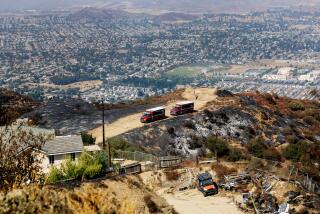Firefighters Battle Blazes as Wildfire Season Comes Early
- Share via
SACRAMENTO — Ushering in what could be a scorching summer of wildfires, a flurry of back-land blazes continued to roar Monday from the Sierra woods to the San Bernardino National Forest.
A fire that erupted in a valley north of Lake Tahoe spread east to within eight miles of Reno by late Monday, charring more than 17,000 acres of timber and continuing to send a plume of smoke over the Nevada gambling city’s high-rise casinos.
“It’s got the whole town socked in,” said Bernie Paul, a California Department of Forestry battalion chief at a command post in Nevada. “It’s kicking up pretty good.”
In the Inland Empire, more than 1,000 firefighters battled three blazes, including a 1,074-acre fire in the San Bernardino National Forest that was not contained after five days.
Record temperatures and low humidity helped fuel conditions that kept firefighters on the defensive throughout the state--and bracing for more blazes as the wildfire season kicks into gear weeks earlier than usual.
“It’s going to be a busy season,” Paul said. “Everyone is already tired, and it’s only mid-June.”
The fire near Tahoe erupted about noon Sunday just east of Truckee and quickly spread along the steep ravines cradling the Truckee River and Interstate 5, which was closed for several hours before reopening in the late evening.
For a few scary hours Sunday, the flames forced the evacuation of about 40 houses, but the winds reversed course and drove the fire back into the wild.
More than 1,600 firefighters tried to hem in the blaze Monday, which burned through heavily wooded terrain before spreading east into Nevada by the afternoon. The fight included 100 fire engines, 40 bulldozers and 19 aircraft dropping water and fire retardant.
Despite the huge amount of turf claimed, there was remarkably little property damage, most of it on the California side.
A mobile home burned in Glenshire. So did three vehicles and a travel trailer in Hirschdale, part of a string of little communities east of Truckee. The fire also scalded the planks of a Union Pacific railroad trestle, Paul said, but a second trestle resumed operations for passenger and freight trains.
One firefighter suffered smoke inhalation Monday but was back on the fire line within a few hours, Paul said.
By late in the day, the fire was hopscotching along remote ridge tops to the south of Interstate 5. Depending on the whims of the winds, the blaze could spread down the eastern Sierra slope into the dry grasslands that stretch toward the western neighborhoods of Reno.
Crews were cutting 50-foot-wide firebreaks west of Reno as a contingency in case flames reach that far.
Full containment of the blaze was not in sight, Paul said, and would largely depend on cooperation from the elements. Winds were whipped at about 20 mph, helping drive the inferno east. In addition, the huge fire was whipping up winds of its own, as air roared in to feed the flames. Adding to the difficulty, humidity dipped to 5%.
The conditions were equally inhospitable as firefighters fought three Southern California blazes.
Temperatures neared 100 degrees, and flames raced up steep, rocky terrain that is difficult to access and is choked by brush that has not burned in three decades.
But firefighters were enjoying one element of atmospheric good luck--mild winds. Moreover, fire officials said, the moisture level in the trees and brush is twice what it would be later in the season.
At least 15 firefighters have been hurt, but none of the injuries were life-threatening, said Melody Lardner, a spokeswoman for the U.S. Forest Service. No communities were threatened, but a California Department of Forestry truck and an abandoned homestead were destroyed, and power lines were in danger.
The San Bernardino National Forest blaze began last week, when officials intentionally ignited a fire to clear brush they believed threatened the nearby communities of Running Springs and Arrow Bear.
An ember sailed over a fire line, setting fire to dry grass. The controlled burn spread quickly, roaring through a remote area known as Keller Ridge.
The Forest Service defended its decision to light the fire.
“With the increasing levels of urbanization, the challenge of protecting both local communities and forest ecosystems is increasing. The San Bernardino National Forest is particularly at risk,” the agency said in a statement. “Unless the buildup of fuels in the area is addressed, it is not a question of ‘if’ but rather ‘when’ a fire will burn through the heavy brush to reach these communities.”
Another consolation: The area where the fire spread was scheduled to be burned intentionally in 2005, Lardner said.
With the flames 75% contained, more than 250 of the 797 firefighters who fought the blaze over the weekend were sent home.
The other two weekend fires were far smaller. A 35-acre fire that began four miles northeast of Big Bear was 60% contained by Monday, Lardner said. Meanwhile, more than 400 firefighters battled a 250-acre fire about eight miles southeast of Hemet in Riverside County. They had it 75% contained.
*
Gold reported from Riverside and Bailey from Sacramento.
More to Read
Sign up for Essential California
The most important California stories and recommendations in your inbox every morning.
You may occasionally receive promotional content from the Los Angeles Times.














